|
I have released five solo CD recordings to between 1995 and 2009 and, in 2006, a recording of Schubert's Winterreise with soprano Louisa Hunter-Bradley.
Each
solo CD was made with a view to publishing distinctive interpretations
of well-known masterpieces in the standard piano repertoire, as follows:
 |
Mozart Piano Sonatas: K.330, K.283, K.545 & K.331 (1995)
My inspiration for this recordings was the groundbreaking approach of
the conductor Nikolaus Harnoncourt in performances of Mozart symphonies
recorded for Teldec with the Royal Concertgebouw Orchestra. Harnoncourt
showed how the great dramatic strength, beauty and excitement that we
associate with Mozart's operas could be realised in a purely symphonic
medium.
My
aim was simply to achieve for the performance of Mozart sonatas on a
modern piano what Harnoncourt had achieved for the performance of
Mozart symphonies using a modern orchestra. This involved a deliberate
rejection of the crippling "Steady on - it's only Mozart!" advice often
forced on the hapless piano student, coupled with a greater reliance on
dynamic contrast than on tempo rubato. The resulting highly
operatic approach used for all four sonatas is particularly evident
throughout the great C major Sonata (K.330) and in the slow movements
of K.283 and K.545.
|
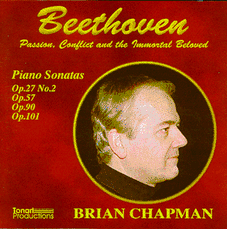 |
Beethoven Piano Sonatas: Op.27 No.2, Opp.57, 90 & 101 (1996)
My main aim in producing this CD was to publish a distinctive interpretation of Beethoven's enigmatic Sonata in A major, Op.101 and
to relate its 'program' biographically to the 'Immortal Beloved'
episode in the composer's life that preceded its composition. The
approach involves an unusually quick tempo for the first
movement, which forms the crucial psychological point of departure for
the entire sonata's 'program'. My secondary aim was to support an
interpretation of Beethoven's Sonata in E minor, Op.90 that accords with the original jesting titles that the composer supplied for the work's two movements.
My approach to the first movement of the 'Appassionata' (Op.57) is deliberately non-episodic while the Op.27 No.2 is
prepared strictly from the Urtext score, thereby excluding all the
innovations of Liszt, von Bülow and Schnabel that have become so widely
influential. Unfortunately, as with all other recordings and
performances of Op.27 No.2 known to me other than my later
2004 recording (see below), no attempt was made here to realise the
composer's directive to play the first movement Alla breve.
|
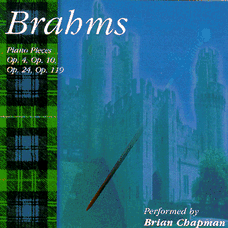 |
Brahms Piano Pieces: Opp.4, 10, 24 & 119 (1997)
The interpretation of Brahms's Four Ballades, Op.10
presented here is starkly opposed to Heinz Becker's incredible
assertion that "the four ballades of Op.10 are so basically different
from one another that one wonders whether they should share one opus
number," published in The New Grove Dictionary of Music and Musicians (MacMillan 1980). In my view, these Four Ballades form
a tightly integrated four-movement suite expressing the tortured
emotional circumstances in which Brahms found himself as tragedy
overtook his friend and mentor, Robert Schumann. To emphasise the link
between Brahms's Op.10 (especially Ballade No.4 that forms the infinitely sad close to the cycle) and the tragedy of Schumann, I have included Schumann's Romanze in F# major, Op.28 No.2 on this CD immediately following Brahms's Op.10 No.4.
The remaining pieces on this CD are simply favourites of mine for which
I have no particular axe to grind other than to express my view that
Brahms's Variations and Fugue on a Theme of Handel is a supreme masterpiece, ranking second to none among works in variation form.
|
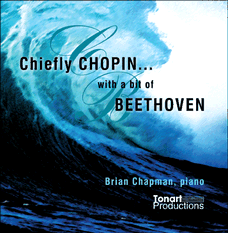 |
Chiefly CHOPIN ... with a bit of BEETHOVEN (2004)
My interpretation of Chopin's greatest piano sonata (Op.58)
represents a departure from the consensus typified by most recordings
of the past 70 years. In my view, the consensus has arrogated to itself
too much artistic licence, combining excessive use of rubato with confused and arbitrary changes of tempo,
so undermining the structural integrity and formal beauty of this work.
My aim has been to interpret the sonata in a way that does justice to
both its Beethovenian structure and its flowing lyrical beauty. By
staying close to the Urtext score, I employ distinctive solutions for tempo in all of the first three movements and, by eschewing rubato in the finale, I show the dramatic possibilities that arise when this movement is taken as a perpetuum mobile to express a powerfully 'driven' response to the tragic grief of the preceding Largo.
The point of including Beethoven's Sonata Op.27 No.2 on this CD was to correct the error in my 1996 recording - an error present in all other recordings known to me - by taking the first movement at a sufficiently fast tempo to realise the true Alla breve pulse required by Beethoven.
|
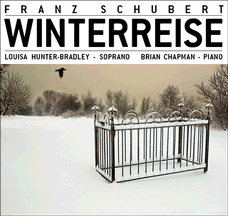 |
FRANZ SCHUBERT: "WINTERREISE" (2006)
This interpretation of
Schubert's greatest song cycle by Louisa Hunter-Bradley (soprano) and
Brian Chapman is one of the few recordings available in which all the
songs are rendered by a female vocalist in Schubert's original keys.
Although the work was originally written for high voice, it was mainly
championed in the 20th century by baritones such as Hans Hotter,
Dietrich Fischer-Dieskau and Olaf Bär. While notable recordings have
been made in the past by women, most of these have been by
mezzo-sopranos and even some sopranos have occasionally used downward
transposition for some of the songs.
Ms
Hunter-Bradley's background as a specialist in Early Music and Baroque
Opera results in an interpretation that is astonishingly fresh, clean
and exciting. This album is released on "The Music Source" label.
|
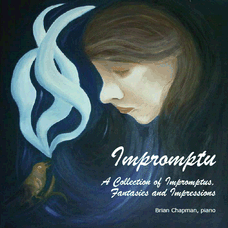 |
IMPROMPTU - A Collection of Impromptus, Fantasies and Impressions" (2009)
While this CD is largely a collection of some personal favourites of mine, there are a few distinctive features:
- an unusually quick tempo - Allegretto, as marked - for Schubert's A flat Impromptu Op.142 No.2;
- a more romantically operatic approach to the Adagio of Mozart's D minor Fantasia, along with a modified 10-bar coda in D minor;
- a proper 'alla breve' approach to the Andante of Beethoven's Sonata quasi una fantasia in E flat, Op.27 No.1.
For more discussion on this latter point see my interpretative analysis of the Adagio sostenuto of Beethoven's "Moonlight" Sonata.
|
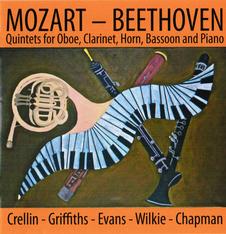 |
MOZART - BEETHOVEN Piano & Wind Quintets (2011)
A Mature Masterpiece and a Youthful Work of Homage
These two Quintets for Piano and Winds
– authored respectively by the 28-year-old Mozart in 1784 and by the
26-year-old Beethoven in 1796 – occupy very different positions
in the outputs of their respective composers.
Mozart, in a letter to his father in March 1784, declared of this Quintet that
“I myself consider it to be the best thing I have written in my life” –
a life that had just over seven years left to run, filled to the end
with a continuing flow of masterpieces.
We have no written record of Beethoven’s opinion of his Quintet,
but we do know that he felt its music worthy of being played more
frequently than could be hoped for in its original instrumentation – he
produced a re-arrangement of the wind parts for violin, viola and
cello, leaving the piano part untouched and publishing the whole
arrangement as the Piano Quartet in E flat, Op.16. As with so many of Beethoven’s early works, the middle ‘slow’ movement is exceedingly beautiful.
|
|
